Group storyboards are a final copy of the shots and elements we will use when we film our piece. The purpose of a group storyboard is so that we can organise our filming schedule correctly so that all our shots are in the order we planned to save confusion and arguments and also include all the group members thoughts an ideas on what will work well and what won't work as well and give the group an opportunity to all agree on the right elements to include. The storyboards have been created by the whole group which we have included the best elements of every members individual storyboards to create a successful and effective opening thriller production.
These are images of our final storyboard which is concluded into 6 pages with 4 frames each. We used 24 frames and we hope we can time these to fit into our 2 minute time frame.
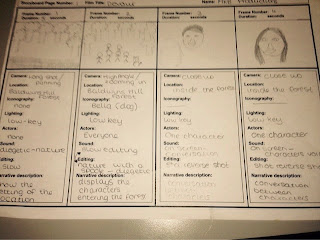
We made the storyboards to refer to throughout the whole process of making our opening thriller sequence. This is because when we are editing our piece we can refer back to our storyboard to remind us of our original ideas that we created to go into that scene and we can also stay organised so that the whole group is familiar with our narrative and also the different elements we will put into the scenes.
We took the idea of a forest setting from Kane's individual storyboard as we liked the idea of the vulnerability and the unknown of the forest that comes with it. We thought the forest setting would be perfect for our narrative which includes a chase scene with quite a large number of characters as it is such a big space with such a high possibility of getting lost which will keep our audience on edge which is conventional to the thriller genre. I had already thought about including the forest setting in my own narrative as I had got inspiration from a clip I analysed thriller conventions from which was Halloween H20 : 20 Years Later. I found this inspirational as I found myself being part of the audience that I instantly felt scared for the characters when I noticed they was in a dark forest, this is because the unknown of what may be lurking in the forest without the characters knowing themselves gives the audience a sense of foreboding.
The main idea of our narrative came from a combination of mine and Malu's individual narrative ideas of a cannibal. We both felt as though the use of the idea of cannibalism was unique and unusual and we could create an entertaining yet interesting storyline with this idea. Combining the idea with the forest setting we took inspiration from Kane's individual narrative we discussed the idea of friends walking their dog unknown to the fact one of their friends was really the cannibal and antagonist and there would be a cannibal attack during the dog walk.
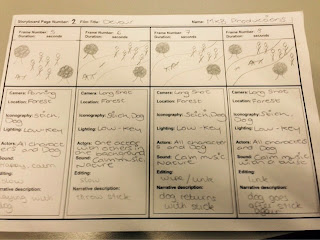
Another idea we took from Malu's individual narrative was the use of a dog. We decided that a realistic narrative that included all our ideas could be friends walking a dog in the forest. The use of a dog gives the scene a sense of reality and makes it easier for the audience to relate to this due to that most of the audience may have a dog themselves as it is a common domestic animal. We decided that most people are aware that dogs can usually sense a bad omen so therefore near the beginning of our scene when the dog goes missing after sensing a bad omen the audience will begin to realise the genre of our piece and also that something bad may happen to the characters they have already built a relationship with and related to for a stronger impact on them.
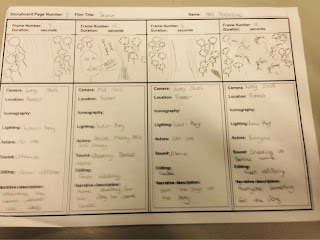
In our piece we have planned to include a range of different shots and cinematography. To start with we have used mainly long shots, panning shots and a gradual zooming in technique. We have used these shots to show the setting and introduce our characters into the scene. I gathered my inspiration of gradual zooming in and panning shots from when I analysed cinematography and used a scene from Insidious. I felt as though when I watched the clip these shots stood out to me immediately for the purpose of causing tension. The slow pace of the shots creates tension for the audience and makes them feel as though something will pop out to scare them but it doesn't happen when they expect which scares them even more.
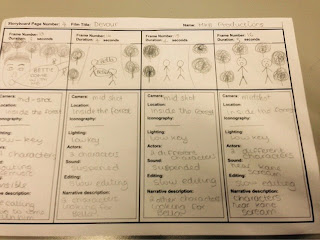
We have also planned to use different elements of cinematography to create different effects four our audience. I also gathered inspiration from a clip from Saw V when I watched it to analyse the mise-en- scene. The main shots used in this clip was close up shots and midshots. This was to clearly show the audience the characters facial expressions and body language to ultimately express how the character is feeling. The close up shots showed the characters uncomfortable and painful look which clearly told the audience that the character was experiencing extreme pain and brutality which made it a bit uncomfortable for the audience to watch which is conventional to the thriller genre. Therefore we have decided to include close up shots on key points in our production to clearly express to the audience how the characters are feeling. For example on the close up of the victims face when the antagonist gets revealed it will show a extremely shocked and frightened face to express their feelings but also show the audience that they are now in danger.
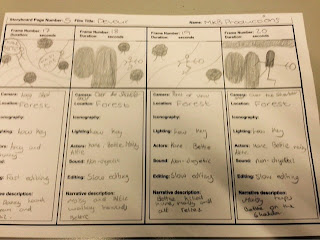
The last element we planned into the majority of our scenes was low key lighting. We got inspiration from the majority of the clips we analysed for example Halloween, Saw and Insidious. With the use of low key lighting it instantly gives the atmosphere a eerie and gloomy aura and makes the audience feel uncomfortable and get a sense of foreboding. The low key lighting represents danger, vulnerability and an enigma. It is also parallel to most of the elements included in that scene as it wouldn't combine with a joyful and happy narrative. All members of my group planned to include low key lighting in their own individual narratives as they believe that this gives the film a more frightening effect and will work well with our unusual and creepy narrative.

You have provided a sound analysis of your group’s storyboard, explaining what your sequence will consist of and giving examples of micro-elements used at different stages.
ReplyDeleteYou need to:
1) Provide a PEER analysis of the micro-elements used from each of your individual storyboards, explaining why you have chosen these specific elements, what they create and WHY, how a relationship can be built and WHY they are conventional of the genre.
2) Conclusion?
3) Double check spelling!!